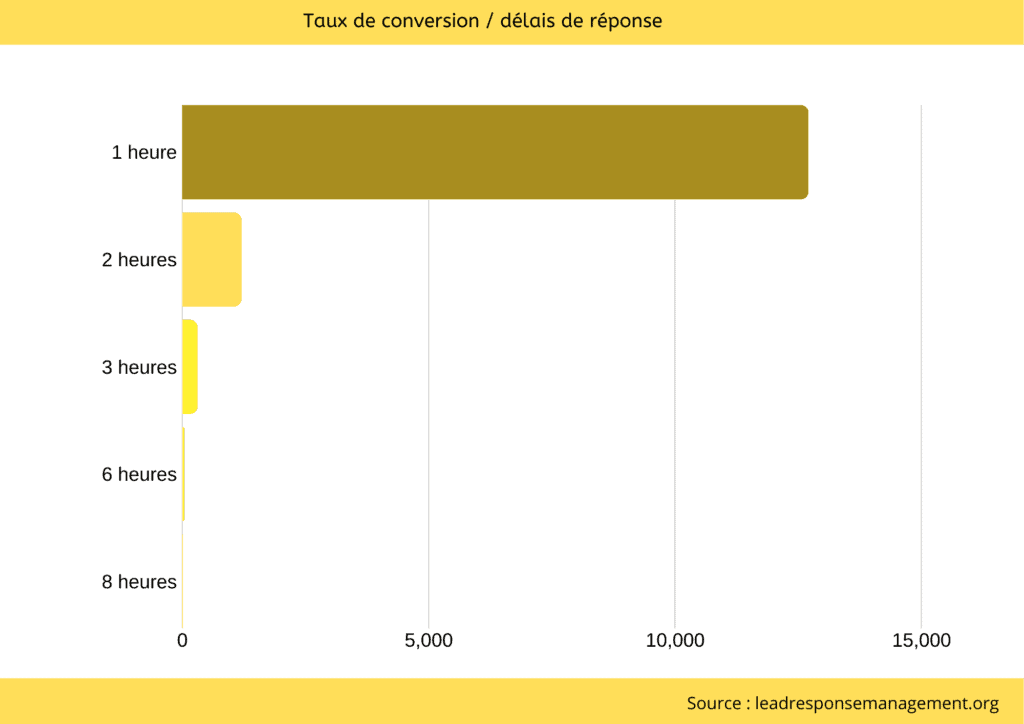Cold calling is a tried and tested method, but it can be tedious and disappointing if we don’t respect certain rules regarding timing! However, if you concentrate your calls on a given time slot, you can hope to double your response rate and therefore your conversion rate.
For effective results we will highlight the best times to call your prospects. Follow the guide.
Sommaire
1. Incoming commercial calls
A prospect who comes to you is a prospect who has already done some work. If there is one detail to focus on with regard to inbound sales calls, it is the response time. Inbound prospecting calls must be taken into consideration very quickly because it is fundamental to be reactive in order to increase your chances of converting the prospect into a future client.
Indeed, if the prospect has taken the step of contacting you, it is because he already knows what you offer and wants more information or to establish a link between you. It is essential to be available to respond to their requests quickly.
The longer the response time, the more likely it is that your prospect will lose interest in you.
In a competitive world, our prospect has probably made the same request to different market players and the one who is the fastest and most convincing will win the competition. It is therefore essential to be the first to respond in order to obtain a better probability of conversion.
Find out how to qualify your prospect in 10 questions.

2. Outbound prospecting calls
In order to make your sales calls more effective and avoid wasting time, it is necessary to plan your cold calling approach.
In addition to making your work less tedious, planning your calls will help you reduce the rate of negative responses.
Choosing your moment
Whether you are calling to get an interview or to make a sale, you need to call your prospects at a time that is most likely to get the message across. There are times of the day when your prospects will be more receptive to your call than at other times. It is true that not all hours are equal in terms of call quality and prospect attention.
Let’s focus on the moments when our target seems to be most available.
Try to focus your prospecting calls at the beginning or end of the day to capture your prospect’s attention outside of their working day.
- Between 8 and 9 a.m., this is the time when we are heading to our workplace and are therefore ready to respond to other demands.
- The same is true for the time between 4 and 6 pm, the so-called ‘soft underbelly’. This is when the mind starts to travel and seeks a way to disconnect from the same daily task. Your prospects will then be more likely to receive your offer.
Not all days of the week are equal when it comes to getting a prospect interested in you. Monday, for example, is probably the worst day for cold calling. Most workers will be very busy with diary planning, meetings, etc., so they won’t really have time to listen to you. Concentrate your prospecting calls in the middle of the week.
- Tuesday and Thursday afternoons seem to be the best times to do your telephone canvassing because our callers seem to have more time and listen more carefully.
However, each call may be different depending on the target you are trying to reach.
It is important to know your target and to separate it by sector of activity in order to best achieve your objectives.
So segment your prospecting calls by sector of activity because each prospect will have different availability depending on their professional activity. Salespeople or craftsmen will be more available in the evening when their day in the field is over.
Once you have defined segments by time slot, chain the calls by sector as it is the repetition that will drive your pitch.
The cost of entry
Another aspect to consider in your prospecting process is the cost of entry for cold calling. Making a cold call every two hours will almost never get you anywhere.
It is important to focus your calls to get the most out of the previous call, and ideally create a collective emulation (a floor in a cold call session is a bit like marching drums).
Not only will you gain in performance on the pure cold call, it is also a great way to structure your sales process. If the cold call sessions are scheduled, the follow-up emails have to go out before the end of the week to be gone before the next session. Unless you only use the phone every other day…? And there you have it, you have created a systematic process for handling your leads (to be refined, of course).
3. Increase response rate
To maximise your chances of getting a positive response, but more importantly a response at all to your telephone canvassing, it is important to develop a quality customer file. To do this, make sure you have the right contact and collect as much information as possible about the prospect.
Information is power
Try to find out as much as possible about your target, their precise identity, their profession, their position etc.
- There is nothing worse than a salesperson who misspells your name or thinks you are the head of a family when you are single!
Also make sure you have the right number and email address so that you don’t waste time calling a fake recipient who will send you away. Prefer a mobile number as soon as possible because it will be easier to reach him/her, especially if you wish to contact him/her outside of his/her working hours.
It is then interesting to know their life and work habits, etc., to know the right moment when they will be able to answer you. Since you will have all the necessary information, it will be easier for you to fit them into the time slot you have defined(previous point).
Planning and research are by far the most important aspects of cold calling. You need to be able to identify the prospects you want to qualify to improve your chances of delivering value.
This refining technique will allow you to identify your prospects as accurately as possible. Calling someone who does not fit your criteria will waste their time. On the other hand, if you call someone who you are sure can benefit from your offer or help, you can help improve their life or the life of their business.
Find our 9 tips for successful cold calling.
Diversify your approach
If the prospect has come to you directly through your website or downloaded your white paper, you will have collected important information about them that will have filled your database.
In this case you will probably have collected their email address which you can use to inform them of your forthcoming call. This allows the prospect to be aware of the procedure but also to find out more about the product/service offered. In this way, they will be able to choose a time slot when they will be fully available and therefore both parties will save time in their approach.
- There is no point in exhausting yourself by calling the same prospect every day at the same time!
It is probably because they are not available at that time. So make sure you set up a system of intelligent rotation in order to vary the times of prospecting calls for the same contact. It is by refining this technique, which can easily be done with a simple Excel table, that your returns will be positive and that you will be able to make the most of your time in these time slots. If you are unable to reach your prospect, you can send him/her back to your marketing team so that they can insert him/her into the lead nurturing.






